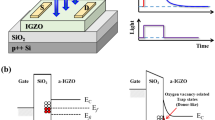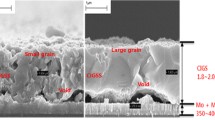Abstract
Deep-level transient spectroscopy (DLTS) is a widely used method to analyze the properties of deep defects in semiconductors. However, it has been rarely reported to measure the deep-levels of highly-doped silicon because the large leakage current badly affects the transient capacitance signal of DLTS technique, due to the trap occupancy dominated by thermal emission instead of capture of carriers. Herein, by employing an asymmetric structure to reduce leakage current, we observed two deep-level defect states of highly phosphorus-doped silicon (7 × 1017 cm−3) in the DLTS spectrum, corresponding to the E-center (vacancy-P trap) and doubly negative charged states. Furthermore, the photocurrent spectrum of the sample under 4 K shows two mid-infrared response peaks, arising from the photoexcitation behavior of the above two defects. This finding provides a new route to measure the deep-level defect properties of highly-doped semiconductor materials using DLTS method. It also suggests potential applications of photoexcitation activity of defects in photoelectric detection.




Similar content being viewed by others
Data and code availability
Original data are available to the readers on personal email request to the corresponding author.
References
Hayne M, Young RJ, Smakman EP, Nowozin T, Hodgson P, Garleff JK, Rambabu P, Koenraad PM, Marent A, Bonato L, Schliwa A, Bimberg D (2013) The structural, electronic and optical properties of GaSb/GaAs nanostructures for charge-based memory, Journal of Physics D. Appl Phys 46:264001–264011
Abramkin DS, Atuchin VV (2022) Novel InGaSb/AlP quantum dots for non-volatile memories. Nanomaterials (Basel) 12:3794–3814
Sebastian A, Le Gallo M, Khaddam-Aljameh R, Eleftheriou E (2020) Memory devices and applications for in-memory computing. Nat Nanotechnol 15:529–544
Seo YJ, Kim KC, Kim TG, Sung YM, Cho HY, Joo MS, Pyi SH (2008) Analysis of electronic memory traps in the oxide-nitride-oxide structure of a polysilicon-oxide-nitride-oxide-semiconductor flash memory. Appl Phys Lett 92:132104–132107
Shi X-L, Chen W-Y, Tao X, Zou J, Chen Z-G (2020) Rational structural design and manipulation advance SnSe thermoelectrics. Mater Horiz 7:3065–3096
Shi XL, Liu WD, Li M, Sun Q, Xu SD, Du D, Zou J, Chen ZG (2022) A Solvothermal synthetic environmental design for high-performance SnSe-based thermoelectric materials. Adv Energy Mater 12:2200670–2200680
Zheng Z-H, Shi X-L, Ao D-W, Liu W-D, Li M, Kou L-Z, Chen Y-X, Li F, Wei M, Liang G-X, Fan P, Lu GQ, Chen Z-G (2022) Harvesting waste heat with flexible Bi2Te3 thermoelectric thin film. Nat Sustain 6:180–191
Yi X, Huang Z, Lin G, Li C, Chen S, Huang W, Li J, Wang J (2017) Simulation of the effects of defects in low temperature Ge buffer layer on dark current of Si-based Ge photodiodes. J Semicond 38:042001–042006
Kumar H, Basu R (2021) Effect of defects on the performance of Si-based GeSn/Ge mid-infrared phototransistors. IEEE Sens J 21:5975–5982
Hallén A, Sundqvist BUR, Paska Z, Svensson BG, Rosling M, Tirén J (1990) Deep level transient spectroscopy analysis of fast ion tracks in silicon. J Appl Phys 67:1266–1271
Peaker AR, Markevich VP, Auret FD, Dobaczewski L, Abrosimov N (2005) The vacancy–donor pair in unstrained silicon, germanium and SiGe alloys. J Phys Condens Matter 17:S2293–S2302
Lang DV (1974) Deep-level transient spectroscopy: a new method to characterize traps in semiconductors. J Appl Phys 45:3023–3032
Poklonski NA, Gorbachuk NI, Shpakovski SV, Filipenia VA, Turtsevich AS, Shvedov SV, Vo Quang N, Binh NTT, Skuratov VA, Wieck AD (2016) DLTS spectra of silicon diodes with p+-n-junction irradiated with high energy krypton ions. Modern Electr Mater 2:48–50
Kindl D, Hubik P, Mares JJ, Kristofik J (2008) Interpretation of the DLTS spectra of silicon p-n junctions prepared by diffusion technique. Int Conf Adv Semiconduct Dev Microsyst 2009:155–158
Ci P, Tian X, Kang J, Salazar A, Eriguchi K, Warkander S, Tang K, Liu J, Chen Y, Tongay S, Walukiewicz W, Miao J, Dubon O, Wu J (2020) Chemical trends of deep levels in van der Waals semiconductors. Nat Commun 11:5373–5380
Lian W, Jiang C, Yin Y, Tang R, Li G, Zhang L, Che B, Chen T (2021) Revealing composition and structure dependent deep-level defect in antimony trisulfide photovoltaics. Nat Commun 12:3260–3266
Aoshima K, Horita M, Suda J (2021) Effect of Schottky barrier height on quantitative analysis of deep-levels in n-type GaN by deep-level transient spectroscopy. AIP Adv 11:115124–115130
Markevich VP, Andersen O, Medvedeva IF, Evans-Freeman JH, Hawkins ID, Murin LI, Dobaczewski L, Peaker AR (2001) Defect reactions associated with the dissociation of the phosphorus–vacancy pair in silicon. Physica B 308–310:513–516
Liu C, Li X, Geng H, Rui E, Yang J, Xiao L (2012) DLTS Studies of bias dependence of defects in silicon NPN bipolar junction transistor irradiated by heavy ions. Nucl Instrum Method Phys Res Sect A 688:7–10
Wakimoto H, Nakazawa H, Matsumoto T, Nabetani Y (2018) Deep level transient spectroscopic analysis of p/n junction implanted with boron in n-type silicon substrate. J Appl Phys 123:161422–161427
Roy K, Mukhopadhyay S, Mahmoodi-Meimand H (2003) Leakage current mechanisms and leakage reduction techniques in deep-submicrometer CMOS circuits. Proc IEEE 91:305–327
Chynoweth AG, Feldmann WL, Lee CA, Logan RA, Pearson GL, Aigrain P (1960) Internal field emission at narrow silicon and germaniump−njunctions. Phys Rev 118:425–434
Gelczuk L, Kopaczek J, Rockett TBO, Richards RD, Kudrawiec R (2017) Deep-level defects in n-type GaAsBi alloys grown by molecular beam epitaxy at low temperature and their influence on optical properties. Sci Rep 7:12824–12834
Capan I, Brodar T, Makino T, Radulovic V, Snoj L (2021) M-center in neutron-irradiated 4H-SiC. Crystals 11:1404–1411
Oanh Vu TK, Tran MT, Tu NX, Thanh Bao NT, Kim EK (2022) Electronic transport mechanism and defect states for p-InP/i-InGaAs/n-InP photodiodes. J Mater Res Technol 19:2742–2749
Chen MC, Lang DV, Dautremont-Smith WC, Sergent AM, Harbison JP (1984) Effects of leakage current on deep level transient spectroscopy. Appl Phys Lett 44:790–792
Kim EK, Cho HY, Min SK, Choh SH, Namba S (1990) Effects of leakage current on isothermal capacitance transient spectroscopy signals for midgap levels in GaAs. J Appl Phys 67:1380–1383
Pan C, Yin Z, Song Z, Yao Y, Zhang Y, Hao J, Kang T, Deng H, Wu H, Dai N (2021) Dark-current-blocking mechanism in BIB far-infrared detectors by interfacial barriers. IEEE Trans Electron Dev 68:2804–2809
Grimmeiss HG, Ovren C (1981) Fundamentals of junction measurements in the study of deep energy levels in semiconductors. J Phys E Sci Instrum 14:1032–1042
Miller GL, Lang DV, Kimerling LC (1977) Capacitance transient spectroscopy. Annu Rev Mater Sci 7:377–448
Watkins GD, Corbett JW (1964) Defects in irradiated silicon: electron paramagnetic resonance and electron-nuclear double resonance of the Si-Ecenter. Phys Rev 134:A1359–A1377
Watkins GD, Corbett JW (1965) Defects in irradiated silicon: electron paramagnetic resonance of the divacancy. Phys Rev 138:A543–A555
Ferenczi G, Kiss J (1981) Principles of the optimum lock-in averageing in DLTS measurement. Acta Phys Acad Sci Hungaricae 50:285–290
Beattie AR, Landsberg PT, (1997) Auger effect in semiconductors, Proceedings of the Royal Society of London. Ser A Math Phys Sci, 249 16–29.
van Roosbroeck W, Shockley W (1954) Photon-radiative recombination of electrons and holes in germanium. Phys Rev 94:1558–1560
Tyagi MS (1984) Minority carrier recombination in heavily-doped silicon. Microelectron Reliab 24:183–184
W.W.J.I.P. Anderson, (1977) Tunnel current limitations of narrow bandgap infrared charge coupled devices, 17 147–164.
Zhu J, Zhu H, Liu M, Wang Y, Xu H, Ali N, Deng H, Tan Z, Cao J, Dai N, Wu H (2021) Ultrabroadband and multiband infrared/terahertz photodetectors with high sensitivity. Photon Res 9:2167–2175
Deng K, Zhang K, Li Q, He T, Xiao Y, Guo J, Zhang T, Zhu H, Wang P, Li N, Hu W (2022) High-operating temperature far-infrared Si: Ga blocked-impurity-band detectors. Appl Phys Lett 120:211103–211110
Sclar N (1984) Properties of doped silicon and Germanium infrared detectors. Prog Quantum Electron 9:149–257
X. Shen, (2002) [Optical Spectroscopy and Properties of Semiconductors], Science, Beijing, 255–260.
Zhu H, Zhu J, Hu W, Xiao Y, Shen J, Li Q, Zhang K, Deng K, He T, Wu H, Li N, Lu W (2021) Temperature-sensitive mechanism for silicon blocked-impurity-band photodetectors. Appl Phys Lett 119:191104–191110
Acknowledgments
This work was supported by the National Natural Science Foundation of China (Nos. 62274168, 11933006 and U2141240), Hangzhou Leading Innovation and Entrepreneurship Team (No. TD2020002), and Key Research Project of Zhejiang Lab (Nos. 2022MD0AL02 and 113013-AL2205).
Author information
Authors and Affiliations
Contributions
This manuscript was written through the contributions of all authors that agreed with this submission. CL prepared the samples and simulated the energy band diagram. WD and CP performed the I-V and C-V measurements. ZY, XL and JL performed the DLTS measurements. TC and YS performed the structural analysis. JZ, HD and ND conceived the project. All authors participated in writing the manuscript and discussing all the results.
Corresponding authors
Ethics declarations
Conflicts of interest
The authors declare no competing financial or ethical interest.
Additional information
Handling Editor: Kevin Jones.
Publisher's Note
Springer Nature remains neutral with regard to jurisdictional claims in published maps and institutional affiliations.
Rights and permissions
Springer Nature or its licensor (e.g. a society or other partner) holds exclusive rights to this article under a publishing agreement with the author(s) or other rightsholder(s); author self-archiving of the accepted manuscript version of this article is solely governed by the terms of such publishing agreement and applicable law.
About this article
Cite this article
Liu, C., Dou, W., Pan, C. et al. Characterization of deep-level defects in highly-doped silicon with asymmetric structure by transient capacitance spectroscopy. J Mater Sci 58, 10651–10659 (2023). https://doi.org/10.1007/s10853-023-08675-1
Received:
Accepted:
Published:
Issue Date:
DOI: https://doi.org/10.1007/s10853-023-08675-1




